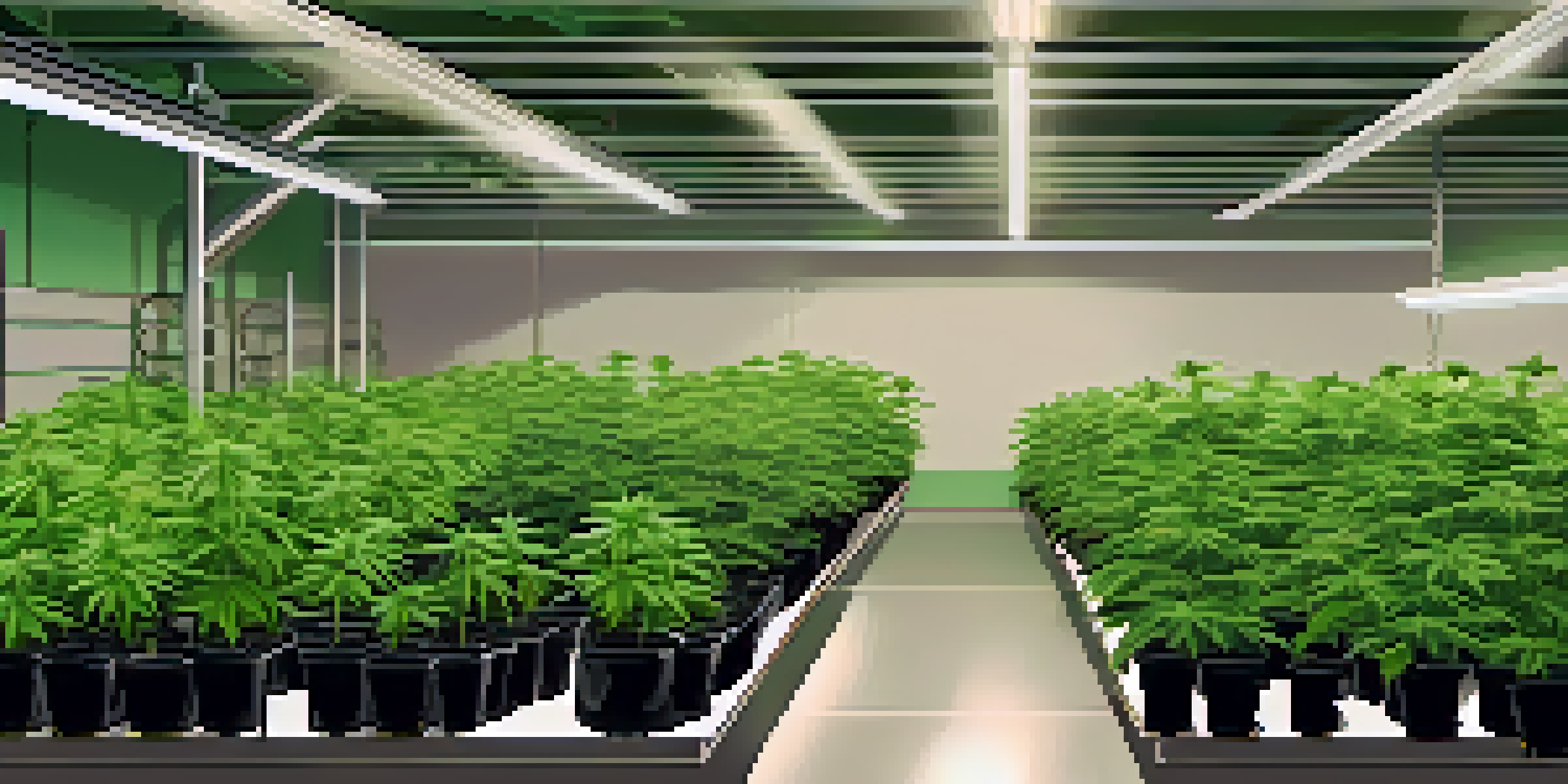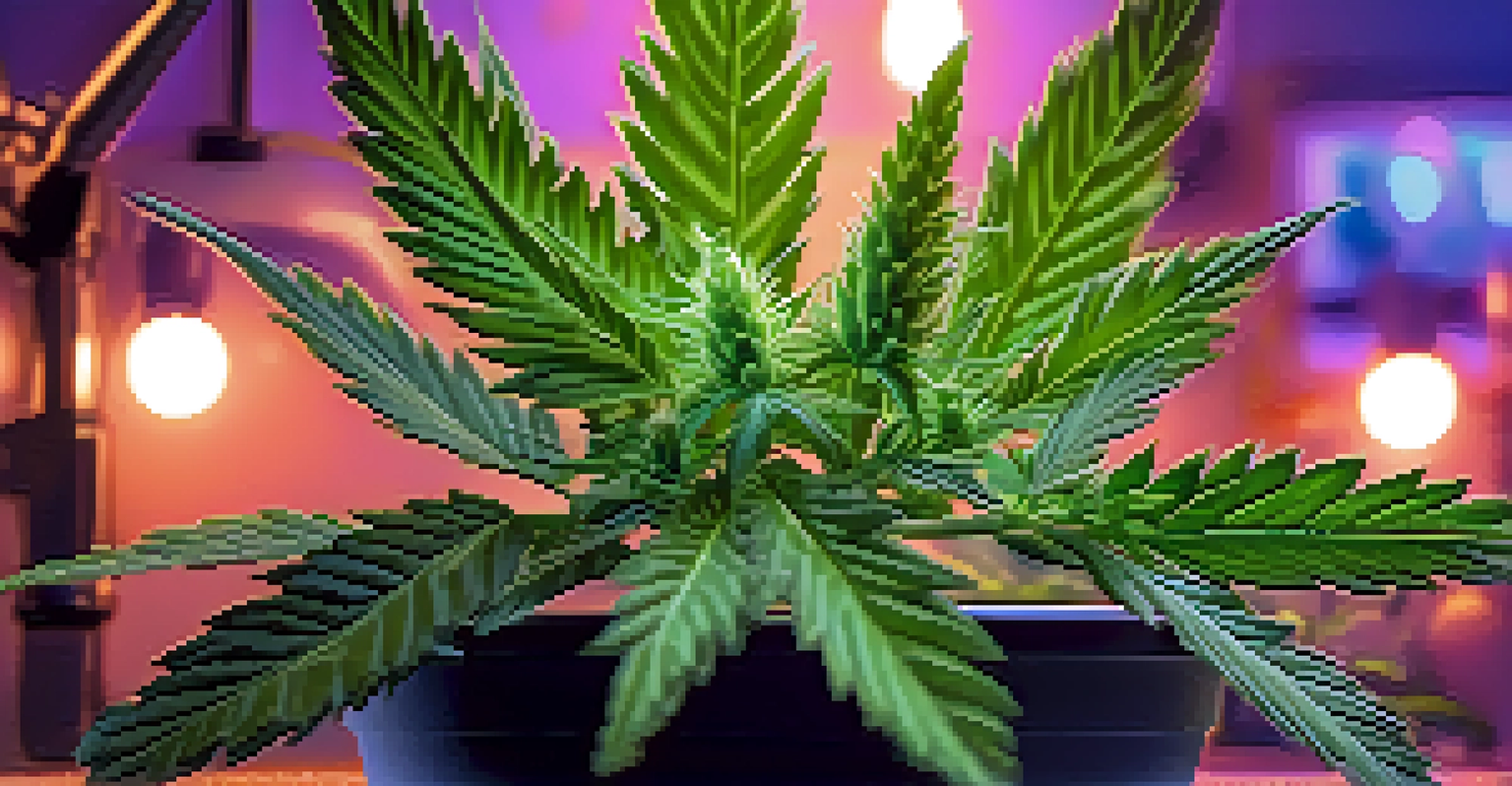Creating Your Own Marijuana Grow Room: A Step-by-Step Guide

Understanding the Basics of a Grow Room Setup
Before diving into the specifics of creating a grow room, it's essential to understand what it entails. A grow room is a controlled environment where you can cultivate marijuana plants indoors. This setup allows you to manage light, temperature, humidity, and ventilation, ensuring optimal growth conditions for your plants.
The greatest gift of the garden is the restoration of the five senses.
Think of your grow room as a mini greenhouse, but with more control over the variables that affect plant health. By regulating these factors, you can mimic the ideal conditions found in nature, promoting healthier plants and potentially higher yields. Understanding these basics sets the foundation for a successful growing experience.
As you embark on this journey, keep in mind that each aspect of your grow room will require careful planning. From the size of the space to the type of lighting you choose, every decision impacts your plants’ growth. So, let’s take a closer look at how to begin setting up your very own grow room.
Selecting the Right Space for Your Grow Room
Choosing the right location for your grow room is crucial. Ideally, you’ll want a space that is clean, discreet, and away from direct sunlight. Common options include basements, spare rooms, or even closets—anywhere that can be adequately controlled for temperature and humidity.

Consider accessibility as well; you’ll need to reach your plants for regular maintenance. Ensure the space has access to electricity and water, as these are essential for your grow lights and irrigation systems. A well-thought-out location not only supports plant growth but also makes the gardening process more enjoyable.
Choose the Right Grow Room Location
Selecting a clean, discreet, and accessible space is crucial for successful indoor plant cultivation.
Additionally, think about security and privacy. If you’re growing in an area where marijuana cultivation is regulated, ensure that your grow room is compliant with local laws. Finding the right space is a fundamental step that sets the stage for a thriving grow room.
Essential Equipment for Your Grow Room
To create a successful grow room, you'll need some essential equipment. This includes grow lights, pots, soil, and a ventilation system. Each item plays a pivotal role in maintaining an environment conducive to plant growth, so it’s important to choose wisely.
Growing your own food is like printing your own money.
For lighting, options like LED or HPS (high-pressure sodium) lights can mimic the sun’s rays, providing your plants with the necessary energy for photosynthesis. Additionally, consider investing in a timer to automate your light cycles, simplifying your routine. Ventilation is equally important, as it helps regulate temperature and prevent mold.
Don’t forget about other tools such as hygrometers to measure humidity and thermometers for temperature checks. By gathering the right equipment upfront, you’ll streamline your growing process and ensure your plants have everything they need to flourish.
Setting Up Lighting for Optimal Growth
Lighting is one of the most critical aspects of any grow room. Plants need light for photosynthesis, which drives their growth, so it’s key to provide them with the right type and amount. Depending on the stage of growth—seedling, vegetative, or flowering—you may need to adjust the intensity and duration of the light.
For seedlings, softer, less intense light helps prevent stress, while flowering plants thrive under brighter light. Most growers use timers to create a consistent light cycle, typically 18 hours of light for vegetative growth and 12 hours for flowering. This consistency mimics natural day and night cycles, promoting healthy plant development.
Essential Equipment for Success
Gathering the right tools, such as grow lights, pots, and ventilation systems, is vital for creating an optimal growing environment.
Remember, the distance between your lights and plants is also crucial. Too close, and you risk burning the plants; too far, and they may stretch and become weak. Finding the right balance is key, and monitoring your plants’ response will guide you in making necessary adjustments.
Controlling Temperature and Humidity Levels
Temperature and humidity are vital to the health of your marijuana plants. Ideally, you should maintain temperatures between 70-85°F (20-30°C) during the day and slightly cooler at night. Higher temperatures can stress plants, while lower temperatures can stunt growth.
Humidity levels vary across the growth stages; seedlings prefer higher humidity (around 65-70%), while flowering plants thrive at lower humidity (40-50%). Investing in a humidifier or dehumidifier can help you maintain these ideal conditions. Regularly monitoring these factors ensures a stable environment for your plants.
Additionally, proper air circulation is essential to prevent hot spots and promote healthy growth. Fans can help distribute air evenly, keeping temperatures consistent. By mastering temperature and humidity control, you’ll create an ideal environment that encourages robust plant growth.
Ventilation: Keeping Air Flowing in Your Grow Room
Ventilation is often overlooked, yet it plays a critical role in a successful grow room. Good airflow helps regulate temperature, removes excess humidity, and provides fresh carbon dioxide for your plants. Without proper ventilation, you risk creating an environment conducive to pests and diseases.
A basic ventilation system includes an intake fan to bring fresh air in and an exhaust fan to push stale air out. Positioning fans strategically can help ensure air circulates evenly throughout the space. Additionally, consider using carbon filters to eliminate odors, especially if your grow room is in a shared space.
Control Temperature and Humidity
Maintaining proper temperature and humidity levels is essential for promoting healthy growth stages in marijuana plants.
Regularly checking for blockages or issues in your ventilation system is essential. Keeping the air fresh and circulating not only benefits your plants but also makes your grow room a more pleasant space to work in.
Watering and Nutrients: Feeding Your Plants Right
Watering and nutrients are the lifeblood of your plants. Understanding when and how to water is essential; overwatering can suffocate roots, while under-watering can stress your plants. A good rule of thumb is to water when the top inch of soil feels dry.
Alongside water, providing the right nutrients is crucial for healthy growth. Marijuana plants require a balanced diet of nitrogen, phosphorus, and potassium, along with various micronutrients. Depending on the growth stage, you might need to adjust the nutrient mix—higher nitrogen during the vegetative stage and more phosphorus and potassium during flowering.

Consider using organic fertilizers for a more sustainable approach, or explore hydroponic systems that allow for precise nutrient delivery. Proper watering and nutrition will significantly impact your plants’ health and yield, setting the stage for a successful harvest.